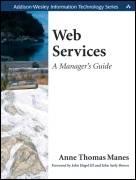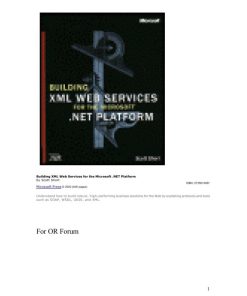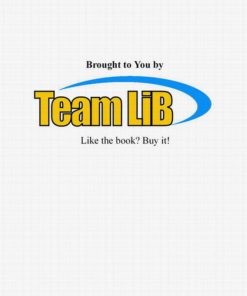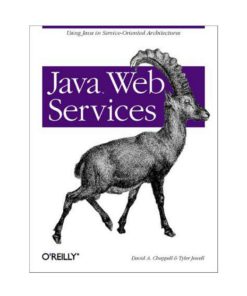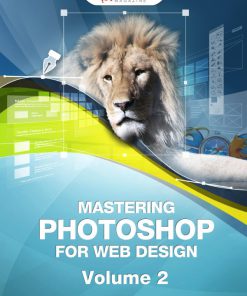Web Services A Manager Guide 1st Edition by Anne Thomas Manes ISBN 0321185773 9780321185778
$50.00 Original price was: $50.00.$25.00Current price is: $25.00.
Authors:By Anne Thomas Manes , Series:Computer Science [248] , Author sort:Manes, By Anne Thomas , Ids:0321185773 , Languages:Languages:eng , Publisher:Addison Wesley , Comments:Comments:Published June 11, 2003, 352 pages.
Web Services A Manager Guide 1st Edition by Anne Thomas Manes – Ebook PDF Instant Download/Delivery. 0321185773 ,9780321185778
Full download Web Services A Manager Guide 1st Edition after payment
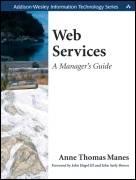
Product details:
ISBN 10: 0321185773
ISBN 13: 9780321185778
Author: Anne Thomas Manes
“This book performs a valuable service for managers seeking to harness the business potential of Web services technology. Bringing a real practitioner’s experience to the task, Anne carefully walks managers through the fundamentals of Web services technology. She does a superb job of helping managers understand this technology so that they can move with sure footing and avoid potentially harmful stumbles along the way.”
–From the Foreword by John Hagel III and John Seely Brown
Written for business and technology managers, Web Services: A Manager’s Guide illuminates the potential of Web services for application integration. It describes the essentials of supporting technologies and shows how they can be built into a Web services infrastructure that is high-performance, robust, and cost-effective.
Realistic in approach, this book offers a readable definition of Web services and non-technical explanations of key technologies and standards. The author explores the scenarios and applications that would benefit most from Web services and offers guidelines for making an informed decision about which Web services products are right for your company’s needs.
You will find detailed coverage of the following topics:
- The advantages of Web services over other middleware technologies
- Various Web services business models, including those used by Google, Kinko’s, Amazon, UPS, and T-Mobile
- The basics of XML, XSLT, SOA, WSDL, UDDI, and SOAP
- How W3C, OASIS, and WS-I are standardizing technologies and defining guidelines for interoperability
- Web services standards for security, transactions, and portlets
- Powerful features of Web services, including dynamic discovery and dynamic binding
- Using Web services for heterogeneous integration, managing legacy assets, and B2B electronic procurement
- Web services core products and platforms
- Evaluating Web services offerings based on such requirements as scalability, extensibility, and security
With this book in hand, you will have a clear understanding of Web services, what the technology can do for your organization, and the direction in which you should be heading. Margin content summaries enable time-constrained managers to locate and absorb needed information quickly. Case studies illustrate the benefits of adopting Web services and also reveal pitfalls to avoid.
Web Services A Manager Guide 1st Edition Table of contents:
1. The Application Integration Crisis.
Hersheys integration nightmare.
Integration helps your business.
All applications require integration.
Calculating return on investment.
Application integration is hard.
Approaches to application integration.
Building integration hooks.
Exposing interfaces across the network.
Middleware styles.
RPC-style middleware.
Traditional Middleware Blues.
Pervasiveness and heterogeneity.
Total cost of ownership.
Extending integration to work across the Internet.
Using the Internet as an integration platform.
Using Web services for integration.
Web services have tactical and strategic value.
2. Web Services Basics.
What is a Web service?
Why Web services?
Defining “Web” and “Service”.
Building services.
Web evolution.
Defining characteristics of Web services.
Understanding the scope of Web services.
Web services business models.
Google.
Kinkos.
Amazon.
UPS.
T-Mobile.
Internal integration.
Executive summary.
3. Web Services Technologies.
The Web.
The Web versus other networks.
XML.
XML Schema.
XSLT.
XML versus other data representations.
SOA.
WSDL, UDDI, and SOAP.
Description (WSDL).
Advertising and Discovery (UDDI).
Communication (SOAP).
Extending SOAP.
SOAP versus other communication systems.
Other Web service technologies.
ebXML.
Executive summary.
4. Standardizing Web Services Technologies.
The history of SOAP.
Challenges with SOAP 1.1.
WS-I.
W3C and OASIS.
The history of WSDL.
Challenges with WSDL 1.1.
The history of UDDI.
UDDI Business Registry.
Private UDDI registries.
Programming standards for Web services.
Java standards for SOAP.
Java standards for WSDL.
Java standards for UDDI.
Executive summary: status check.
5. Advanced Web Services Standards.
Web services security standardization efforts.
Confidentiality and integrity.
Authentication and authorization.
Using XML security in Web services.
Web services management standardization efforts.
Transactions, Orchestration, and Choreography.
Transactions.
Orchestration/Choreography.
Reliability.
Portlets and interactive applications.
Other advanced efforts.
6. The Promise of Web Services.
Web services hype.
Super-powered PDA.
Software-as-a-service.
Dynamic discovery of business partners.
Enabling dynamic discovery.
Domain-specific industry standards.
Dynamic binding.
What makes Web services special.
Web services adoption.
Clear benefits.
Truth in hype.
7. When to Use Web Services.
Bell ringers.
Heterogeneous integration.
Unknown client environment.
Multi-channel client formats.
Other Web services applications.
Point-to-point integration.
Consolidated view.
Managing legacy assets.
Reducing duplicative applications.
Managing portal initiatives.
B2B electronic procurement.
Trading partner network.
Software as a service.
When not to use Web services.
Executive Summary.
8. Web Services Infrastructure.
Core Products.
Web Services Platforms.
Web services management extensions.
Infrastructure-level Web services.
Associated Products.
9. Evaluation Guidelines.
Characterize your project.
Making the initial cut.
Language and operating system.
Selecting a Java platform.
Licensing and support issues.
Evaluating your requirements.
Performance and scalability.
Standards support and interoperability.
Extensibility features.
Security.
Tools.
UDDI Registries.
Platform considerations.
Standards support.
User interfaces.
Administration and management.
Security.
Executive summary.
Base your selection on project requirements.
Charting your course.
Appendix A: Web Services Product List.
.NET Platform.
COM Platform.
Portable C and C++ Platforms.
Java platforms.
J2EE platforms.
J2SE Platforms.
J2ME and KVM platforms.
Other languages and platforms.
Scripting languages.
Programming languages.
UDDI Registry Servers.
Embedded UDDI Registries.
Standalone UDDI Registries.
Appendix B: Requirements Questionnaire.
Operating platform attributes.
Client platform attributes.
Licensing requirements.
Performance and scalability requirements.
Extensibility features.
Security requirements.
Developer preferences.
UDDI requirements.
People also search for Web Services A Manager Guide 1st Edition:
web services manager
web-mgmt-service
azure web management service
amazon web services manager salary
You may also like…
eBook PDF
Building XML Web Services for the Microsoft 1st edition by Scott Short ISBN 0735614067 9780735614062
eBook PDF
Web Services Principles and Technology 1st Edition by Michael Papazoglou 0321155556 978-0321155559

